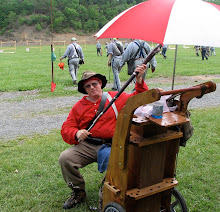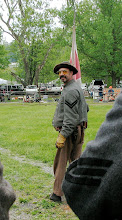from the
Southern Historical Papers, 1904:
Southern Historical Society Papers
Vol. XXXII. Richmond, Va., January-December. 1904, pp. 174-178
Company C, 4th Virginia Infantry, at the First Battle of Manassas, July 18, 1861
THE ORIGINAL REBEL YELL
With Prefatory Note by U. S. Senator, J. W. Daniel
BY J. B. CADDALL
[From the Richmond, Va., Times-Dispatch, Nov. 27, 1904]
Editor of The Times-Dispatch:
SIR,–In forming his line of battle at first Manassas Jackson placed the 4th Virginia Infantry, under Colonel James F. Preston, in rear of his artillery as an immediate support, and the 27th Virginia Infantry, under Lieutenant-Colonel John Echols, in close order directly behind the 4th. The two regiments, except without the line of the 4th, was larger than the 29th, on account of its larger numbers, appeared as one body, four ranks deep. To the left of those two regiments, and almost at a right angle, was the 5th Virginia, under Colonel Kenton Harper, and to their left in the woods, were the 2d Virginia, under Colonel James W. Allen (who was afterwards killed at Gaines’ Mill) and then the 33d Virginia, under Colonel Arthur Cummings, constituted the left flank of the brigade.
When the critical juncture came, Jackson galloped to the right of the Fourth Virginia, called for Colonel Preston, told him in a few sharp words to “order the men behind, up,” and to “charge and drive them to Washington!” “Attention!” “Forward march!” “Left oblique march!” were the commands quickly given; “left oblique,” an order to press the left flank of our artillery, which was between our infantry and Pickett’s and Griffin’s guns, which were to be charged.
Mr. J. B. Caddall, of Pulaski, was then in the 4th Virginia, and he gives an account, afterwards endorsed, with some interesting incidents of this regiment.
 It is a notable fact that Jackson’s brigade line furnished the first immovable obstacle to McDowell’s advance, for while all the troops acted gallantly that day those previously engaged had been unable to withstand the weight of numbers thrown against them. The first stand of Jackson and his timely onset, alike checked, halted and repulsed the enemy, and then joined with arriving reinforcements, in driving them from the field.
It is a notable fact that Jackson’s brigade line furnished the first immovable obstacle to McDowell’s advance, for while all the troops acted gallantly that day those previously engaged had been unable to withstand the weight of numbers thrown against them. The first stand of Jackson and his timely onset, alike checked, halted and repulsed the enemy, and then joined with arriving reinforcements, in driving them from the field.
Mr. Caddall calls attention to the fact that “the rebel yell” made its first appearance in the cheer of Jackson’s men in their charge.
The “four deep” line of the 4th and 27th Virginia was a formation that we do not hear of on any other field. It proved particularly fortunate and efficient on this occasion, but it escapes the notice of most historians, even of Colonel Henderson, one of the most accurate, as well as most wise, graphic and brilliant of military writers. The heaviest loss on Jackson’s regiment fell upon the 27th Virginia, which, namely, 141 killed and wounded, nineteen of whom were killed, and this gallant little regiment was afterwards called “The bloody Twenty-seventh.”
JOHN W. DANIEL
Lynchburg, Va., November 18, 1904
—–
THE PULASKI GUARDS
On the 23d of April, 1861, in the old City Hall, in Richmond, “The Pulaski Guards,” commanded by Captain James A. Walker, was mustered into the service of the State of Virginia by Colonel John B. Baldwin, of Staunton, inspector-general of the militia of the State.
This company, which had been organized a year or more previously, was composed of sixty strong, stalwart young men, ranging in their ages principally from eighteen to thirty years, though there were several older men who had seen service in the United States army in Mexico, and with General Albert Sidney Johnston on the Western plains. Among the veterans were R. D. Gardner, first lieutenant of the company, later noted for his coolness and courage in leading his regiment as lieutenant-colonel into battle; Theophilus J. Cocke, Robert Lorton, John Owens, and David Scantlon, the company’s drummer.
This company, designated as “Company C,” constituted a part of the newly organized 4th Regiment of Virginia infantry, under the command of Colonel James F. Preston, who had been a captain in the Mexican war. The 4th Regiment was ordered to Harper’s Ferry, where it was organized into a brigade, with the 2d, 5th, 27th and 33d Virginia Regiments, and the brigade was known as the 1st Brigade of the Army of the Shenandoah. This brigade was commanded by Brigadier-General T. J. Jackson, and constituted a part of General Joseph E. Johnston’s command in the Valley of Virginia on the 18th of July, 1861. General Johnston, with his forces from the Valley, was ordered to join General Beauregard at Manassas. In the disposition of the forces, Beauregard occupied a line along Bull Run on July 21, 1861. General Johnston was on his left, with his line thrown back at something like a right angle below the stone bridge, to protect the left flank of the army. Jackson’s brigade was placed on the left of Hampton, Bartow and Bee, which commands had previously taken positions on the field, and General Jackson made the following disposition of his force: The Rockbridge Artillery, under the Rev. W. N. Pendleton, as captain, which had been attached to the brigade, was placed in position on the crest of the hill to the right of the Henry house, commanding the plateau towards the stone house on the Sudley road.
Immediately in the rear of and supporting this battery was the 4th Regiment, under Colonel James F. Preston, with the 27th Regiment, under Lieutenant-Colonel John Echols, formed a few paces in its rear. The 5th Regiment was on the right of the brigade, and the 33d and 2d Virginia Regiments on the left. This position was maintained for two hours in a broiling July sun in an open field, subjected to a fire from the artillery of the enemy from which the two regiments, 4th and 27th, immediately in rear of the battery, suffered serious loss.
At about 3 o’clock the enemy had pushed forward a strong column of infantry and artillery, and had arrived in close proximity of Jackson’s left flank near the Henry House. At this time the men of the 4th Regiment were lying flat on their faces on the ground in the rear of the battery to escape the heavy artillery fire of the enemy when we were called to attention and ordered forward on the double-quick, and on an oblique move to the left over a stake and brush fence, through a skirt of pines and subject to a heavy fire of musketry. In a very few minutes we were in close contact with the ranks of the enemy of which a very conspicuous body was a Zouave Regiment from New York, with highly decorated uniforms, consisting of loosely fitting red breeches, blue blouses, with Turkish tassel as headgear.
Jackson’s men rushed at them, with fixed bayonets, every man yelling at the top of his voice. Here was the origin of the “Rebel yell,” which afterwards became so conspicuous in later battles of the Army of Northern Virginia. The men fired as rapidly as they could load their old smooth-bore muskets, and in a few minutes the Confederates were in full possession of that part of the field, and a fine battery of field artillery, Ricketts, which was in position near the Henry House, was captured.
The charge of Jackson’s brigade on that day turned the tide of battle, which to that time had seemed against the Confederates, and in a short time there was not to be seen an organized body of Federals south of Bull Run, but their forces were in rapid retreat toward Washington.
Company “C,” of which the writer was a member, was the color, or flag company of the regiment, and suffered a heavy loss–seven killed and twenty-three wounded. The flagstaff was shot in two, the color-bearer immediately repairing the damage by lashing a bayonet over the break and proceeded with the regiment in the charge.
David H. Scantlon, who was an enlisted member of Company C, 4th Virginia Infantry (Pulaski Guards), had seen service in the Mexican war and was an expert drummer. He was noted for his orderly habits and his strict obedience and observance of military discipline. He was drummer for the volunteer company before entering the Confederate army, and they had bought for his use a handsome brass kettle drum, which had a clear, ringing tone. Scantlon prized this drum very highly, and at all times exercised for it the most scrupulous care. In the army he was chief drummer for the regiment, and always seemed filled with enthusiasm when, with two other drums and the shrill notes of a couple of fifes playing “Highland Mary,” or “The Girl I Left Behind Me,” he marched at the head of the regiment at dress parade or in review.
Scantlon accompanied the 4th Regiment in the charge of the battle of Manassas, and after the capture of the Rickett’s Battery, the regiment being in some confusion, he was ordered by Colonel Preston to beat “the rally,” which he immediately proceeded to do, after first having turned his back to the enemy. On being asked by an officer near him why he turned his back to the enemy, he replied:
“Do you suppose I want the Yankees to shoot a hole through my new brass drum?”
One more humorous incident: While the 4th was lying in the rear of the Rockbridge Artillery, the men flat on their faces to lessen the exposure to the heavy artillery fire of the enemy, and while their shells were shrieking very close over us or exploding about us, a member of the company was very zealously and earnestly calling upon the Lord for mercy, for protection, and for help in the time of such imminent danger. During his devotions he would tell the Lord that he had been all through Mexico, but he had never seen anything half so bad as that; just then another shell would whistle over in very close proximity, when with the greatest earnestness he would exclaim:
“Oh, Lord, have mercy on me!”
At this point a comrade near his side would respond: “Me, too, Lord,” whether from inability to frame his own supplications or in a spirit of humor, no one then present took occasion to enquire.
J. B. CADDALL
Co. C, 4th Va. Infantry
xxx
It is a notable fact that Jackson’s brigade line furnished the first immovable obstacle to McDowell’s advance, for while all the troops acted gallantly that day those previously engaged had been unable to withstand the weight of numbers thrown against them. The first stand of Jackson and his timely onset, alike checked, halted and repulsed the enemy, and then joined with arriving reinforcements, in driving them from the field.


















I found a .wav file online of some Confederate Veterans at a reunion giving demonstrating the rebel yell. I'll post it here, or send it to someone who can post it.
ReplyDeleteJon